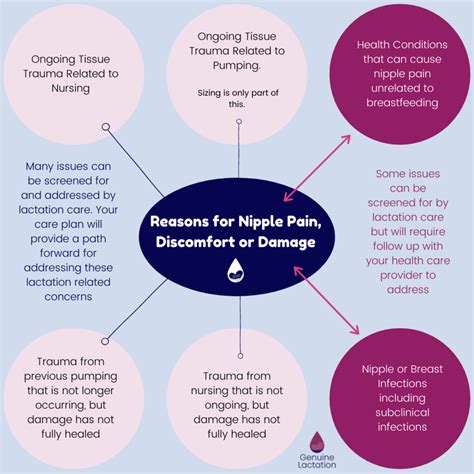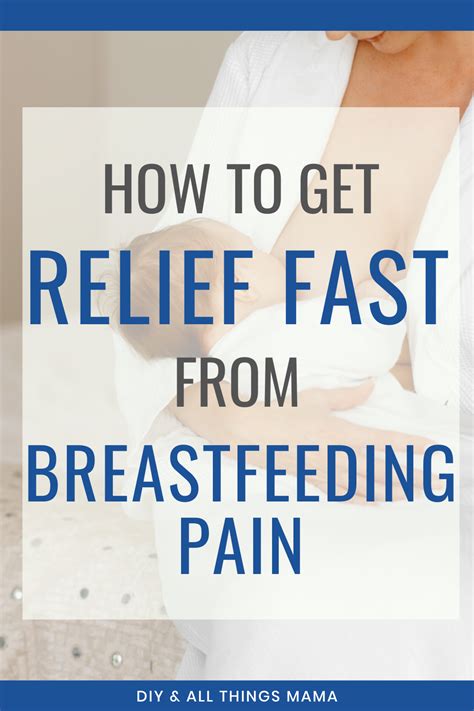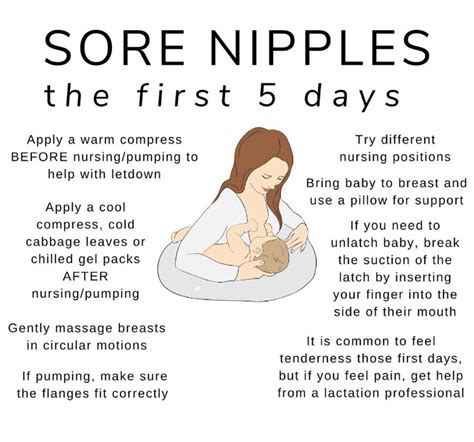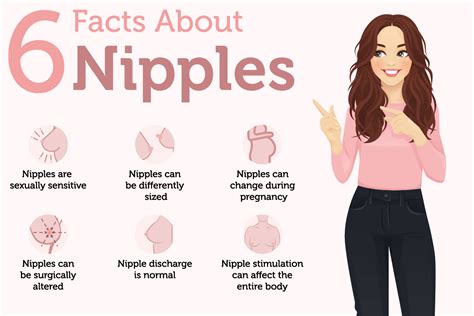Intro
Nipple pain is a common issue that many breastfeeding mothers face, and it can be a significant barrier to successful breastfeeding. The pain can range from mild discomfort to severe pain, and it can be caused by a variety of factors. Understanding the causes of nipple pain and taking steps to prevent and manage it can help mothers to continue breastfeeding and provide their babies with the numerous benefits of breast milk.
Breastfeeding is a natural and essential part of caring for a newborn, and it provides numerous benefits for both the mother and the baby. Breast milk is rich in nutrients, antibodies, and other beneficial compounds that help to promote healthy growth and development in babies. It also helps to strengthen the bond between the mother and the baby, and it can reduce the risk of various health problems, such as respiratory infections, diarrhea, and ear infections. However, nipple pain can make breastfeeding a challenging and uncomfortable experience for many mothers.
Nipple pain can be caused by a variety of factors, including poor latching, tongue-tie, nipple trauma, and infections. Poor latching is one of the most common causes of nipple pain, and it occurs when the baby does not properly attach to the breast. This can cause the nipple to become compressed and irritated, leading to pain and discomfort. Tongue-tie is another common cause of nipple pain, and it occurs when the baby's tongue is attached too tightly to the floor of the mouth. This can make it difficult for the baby to properly latch onto the breast, leading to nipple pain and other breastfeeding problems.
Nipple Pain Causes and Prevention

Preventing nipple pain is essential to ensuring a comfortable and successful breastfeeding experience. There are several steps that mothers can take to prevent nipple pain, including proper latching, frequent feeding, and good breast care. Proper latching is critical to preventing nipple pain, and it involves ensuring that the baby is properly attached to the breast. This can be achieved by guiding the baby onto the breast, ensuring that the mouth is wide open, and that the nipple is far back in the mouth. Frequent feeding is also essential to preventing nipple pain, as it helps to keep the breasts empty and reduces the risk of engorgement and other breastfeeding problems.
Proper Latching Techniques
Proper latching techniques are essential to preventing nipple pain and ensuring a comfortable breastfeeding experience. The following are some tips for proper latching: * Ensure that the baby is properly positioned, with the mouth wide open and the nipple far back in the mouth. * Guide the baby onto the breast, rather than forcing the breast into the baby's mouth. * Ensure that the baby's tongue is extended and that the lips are sealed around the areola. * Monitor the baby's sucking pattern, and adjust the latching as needed to ensure that the nipple is not being compressed or irritated.Nipple Pain Treatment and Management

Managing nipple pain is essential to ensuring a comfortable and successful breastfeeding experience. There are several treatment options available for nipple pain, including topical creams, cold compresses, and nipple shields. Topical creams, such as lanolin and breast milk, can help to soothe and protect the nipples, reducing pain and discomfort. Cold compresses can also help to reduce pain and inflammation, and they can be applied to the nipples after feeding. Nipple shields are another treatment option for nipple pain, and they can help to protect the nipples during feeding.
Nipple Pain Relief Remedies
There are several remedies that can help to relieve nipple pain, including: * Applying topical creams, such as lanolin and breast milk, to the nipples after feeding. * Using cold compresses to reduce pain and inflammation. * Wearing comfortable and supportive clothing, such as a good bra, to reduce pressure on the breasts. * Avoiding irritants, such as soap and detergent, that can dry out and irritate the nipples. * Getting plenty of rest and practicing good breast care to reduce the risk of breastfeeding problems.Nipple Pain and Breastfeeding Success

Nipple pain can be a significant barrier to breastfeeding success, but it is not a reason to give up on breastfeeding. With proper treatment and management, mothers can overcome nipple pain and continue to breastfeed their babies. It is essential to seek help from a lactation consultant or other breastfeeding professional if nipple pain persists or is severe. They can provide guidance and support to help mothers to overcome nipple pain and achieve breastfeeding success.
Benefits of Breastfeeding
Breastfeeding provides numerous benefits for both the mother and the baby, including: * Providing essential nutrients and antibodies that help to promote healthy growth and development. * Strengthening the bond between the mother and the baby. * Reducing the risk of various health problems, such as respiratory infections, diarrhea, and ear infections. * Helping to regulate the baby's digestive system and prevent constipation. * Providing a sense of comfort and security for the baby.Nipple Pain and Breastfeeding Positions

Breastfeeding positions can also play a role in nipple pain, and finding a comfortable and supportive position can help to reduce pain and discomfort. The following are some tips for finding a comfortable breastfeeding position:
- Experiment with different positions, such as the cradle hold, football hold, and side-lying position, to find one that is comfortable and supportive.
- Use pillows and other supports to help maintain a comfortable position and reduce pressure on the breasts.
- Avoid positions that put pressure on the breasts or nipples, such as lying on the stomach or bending forward.
- Take regular breaks to stretch and move around, and to give the breasts a chance to rest and recover.
Common Breastfeeding Positions
There are several common breastfeeding positions that mothers can try, including: * The cradle hold, where the baby is held in the crook of the arm and the breast is supported by the hand. * The football hold, where the baby is held under the arm and the breast is supported by the hand. * The side-lying position, where the mother lies on her side and the baby is positioned beside her. * The laid-back position, where the mother reclines back and the baby is positioned on top of her.What are the most common causes of nipple pain during breastfeeding?
+The most common causes of nipple pain during breastfeeding include poor latching, tongue-tie, nipple trauma, and infections. Poor latching is one of the most common causes of nipple pain, and it occurs when the baby does not properly attach to the breast.
How can I prevent nipple pain during breastfeeding?
+Preventing nipple pain during breastfeeding involves proper latching, frequent feeding, and good breast care. Proper latching is critical to preventing nipple pain, and it involves ensuring that the baby is properly attached to the breast.
What are some treatment options for nipple pain during breastfeeding?
+There are several treatment options for nipple pain during breastfeeding, including topical creams, cold compresses, and nipple shields. Topical creams, such as lanolin and breast milk, can help to soothe and protect the nipples, reducing pain and discomfort.
We hope this article has provided you with helpful information and tips on managing nipple pain during breastfeeding. If you have any further questions or concerns, please do not hesitate to reach out to a lactation consultant or other breastfeeding professional. Remember, nipple pain is a common issue that many breastfeeding mothers face, but it is not a reason to give up on breastfeeding. With proper treatment and management, mothers can overcome nipple pain and continue to breastfeed their babies, providing them with the numerous benefits of breast milk.
